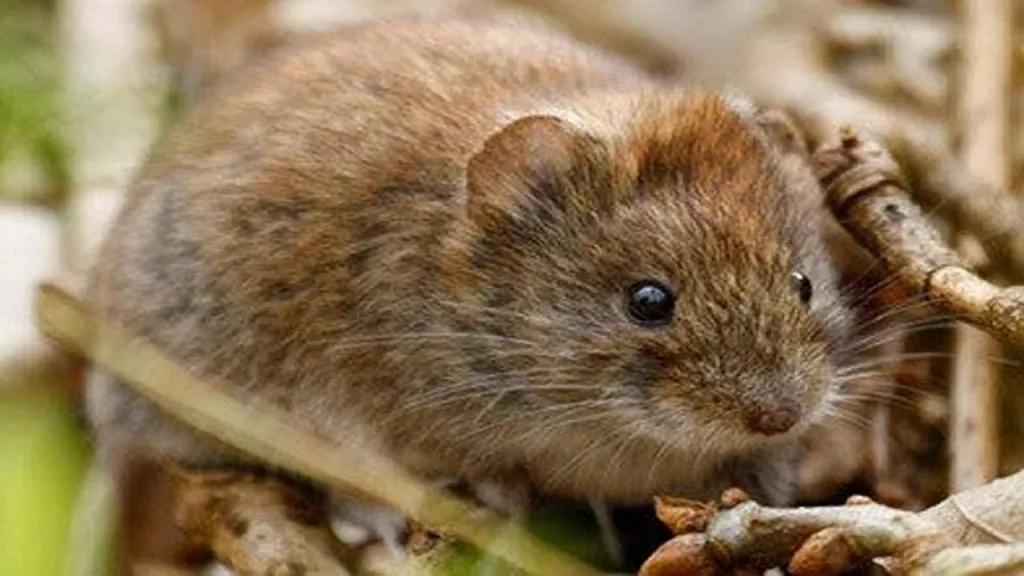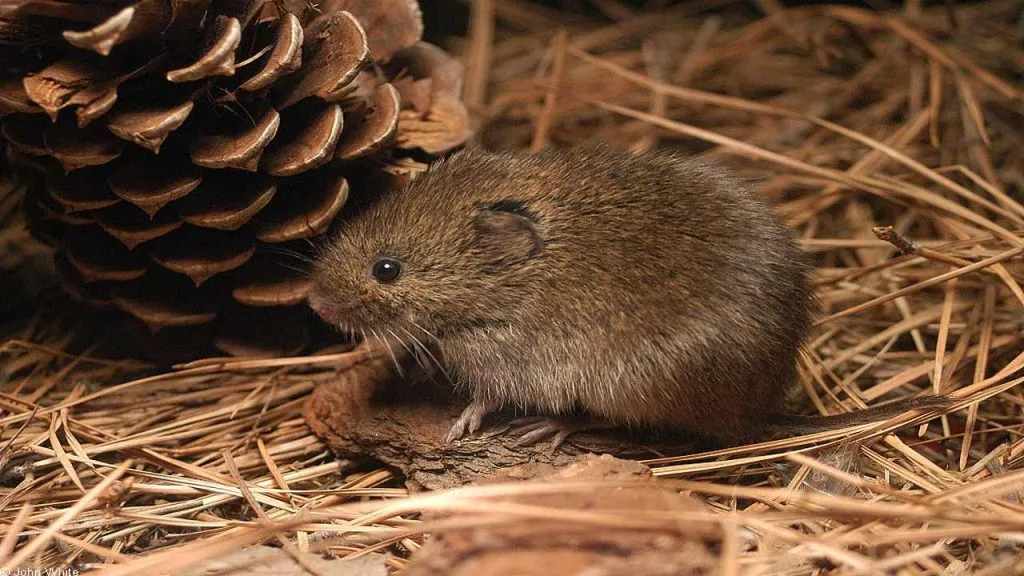As an Amazon Associate I earn from qualifying purchases.
Meadow voles inhabit North America, Europe, and Asia, thriving in diverse environments such as prairies, meadows, damp areas, fields, woods, steppes, and mountainous regions up to 4,000 meters above sea level.
These small rodents have short, thick fur in shades of brown or grey, with petite eyes and ears, and tails shorter than their bodies.
Adult voles typically measure 5 to 8 centimeters long and weigh between 20 to 40 grams.
Their intriguing dietary habits, which vary with the seasons and life stages, make them fascinating creatures to study.
In this article, we’ll explore what meadow voles eat, how they locate their food, and uncover some captivating facts about these tiny foragers.
What Do Meadow Voles Eat Throughout The Year?

Meadow voles, which are small rodents commonly found throughout North America, eat a variety of foods that change with the seasons and food availability.
They mainly eat plants but will switch to other foods when needed.
In spring and summer, when it’s warmer, meadow voles munch on a lot of different plants found in their grassy homes.
They especially like tender shoots and young plants because they’re packed with nutrients and give them the energy they need. They also eat seeds and grains during this time.
As fall comes and plants start to die off, meadow voles change their diet. They might eat more seeds, grains, and nuts to store up food for winter.
Winter is tough for meadow voles since snow covers the ground and plants are hard to find. To survive, they eat the bark, twigs, and roots of shrubs and trees.
They also rely on seeds and grains they’ve hidden away during warmer months. Sometimes, they’ll eat insects they come across while looking for food, like beetles, caterpillars, and grasshoppers.
Occasionally, meadow voles might eat fungi, especially certain mushrooms that grow where they live. But fungi aren’t a big part of their diet compared to plants.
Here is a list of food that Meadow voles eat
- Grasses
- Sedges
- Herbs
- Foliage
- Seeds
- Grains
- Bark
- Twigs
- Roots
- Insects
- Fungi
- Stored Food
To wrap it up, meadow voles are pretty flexible eaters. They chow down on lots of different plants and sometimes mix them up with seeds, grains, and other plant-based snacks.
This adaptability helps them survive in all sorts of places and deal with changes in food supply throughout the year.
What Do Baby Meadow Voles Eat?
Baby meadow voles, or pups, have specific food needs as they grow.
At first, they depend entirely on their mother’s milk, which gives them vital nutrients and antibodies needed for survival. As they get older and more self-sufficient, they start eating solid food.
Around two to three weeks old, the pups begin to try out soft, easy-to-digest plants near their nest or burrow.
This might be tender shoots, young leaves, and seeds brought by their mother.
During this time, the mother vole is essential in showing her young ones where to find food and how to search effectively.
As the pups mature, they broaden their diet to include more types of plants and seeds, similar to what adult meadow voles eat.
By four to six weeks old, they are weaned off milk completely and can find food on their own.
In short, baby meadow voles start by drinking their mother’s milk and then slowly start eating solid food as they grow up.
Their diet expands from soft plants provided by their mother to a wider variety of plants and seeds as they become independent.
How Do Meadow Voles Find Its Food: The Hunting Method of Meadow Voles
Meadow voles aren’t the hunting type like carnivores; they’re herbivores, meaning they munch on plants instead of chasing after prey.
Their diet is all about greens: grasses, sedges, herbs, and other plant goodies they find in their grassy homes.
But every once in a while, these voles might switch it up and snack on small bugs like insects if they stumble upon them while searching for food.
It’s more of a spur-of-the-moment thing and usually happens when their usual plant snacks are hard to find.
While they’re not out there stalking prey like predators, meadow voles still have a knack for finding food.
They rely on their sharp sense of smell and their knack for navigating through their habitat to track down tasty vegetation.
They’re more about gathering plants for a meal than actively hunting down other creatures.
Interesting Facts About The Meadow Voles

Meadow voles may not be in the spotlight often, but they’re quite fascinating creatures. Here are some neat things to know about them:
1. Reproductive Prowess
Meadow voles are known for their impressive ability to have lots of babies in a short amount of time.
They can have many litters in just one year, especially when conditions are just right. This helps their population stay strong and healthy.
2. Social Creatures
Despite mostly going solo when searching for food, meadow voles build homes together underground.
They share tunnels and rooms with other voles, kind of like roommates. Living together helps them stay safe and communicate with each other.
3. They’re Like Little Gardeners
Meadow voles play an important role in shaping their habitat. They munch on plants and dig tunnels in the ground, which changes how the plants grow and how the soil works.
This helps other animals and plants in their environment.
4. They Can Live Anywhere
Meadow voles are incredibly adaptable creatures. They can thrive in many different environments, from grasslands to marshes to forests.
They’re skilled at changing their habits and finding new food when their surroundings change.
5. Predator-Prey Dynamics
Despite their small size, meadow voles are a crucial part of their ecosystem. Many animals like owls, hawks, snakes, and small carnivores depend on them for food.
With so many predators after them, they help keep the balance in the food chain.
6. Seasonal Variations
Just like people, meadow voles change their behavior with the seasons. They eat different foods and do different things depending on whether it’s hot or cold.
They’re good at adapting to whatever the weather brings, which helps them survive all year long.
So, even though they might seem like just another small animal, meadow voles have a lot going on that makes them pretty special in their own way.
Conclusion
In summary, even though meadow voles are small, they have a big impact on their surroundings.
They affect their ecosystem by what they eat and how they act. Whether they’re munching on plants or sometimes hunting for food, these tough little rodents have smart ways to stay alive and do well in their grassy homes.
Learning about what they eat and how they live helps us understand more about the complex balance of life in nature.
FAQ’s:
Meadow voles are usually attracted to a variety of food, but some effective baits include peanut butter, oatmeal, and small pieces of fresh fruits or vegetables.
Meadow voles typically have a lifespan of about 1 to 2 years in the wild, although some may live longer under optimal conditions.
Meadow voles are not generally harmful to humans, but they can cause damage to crops and gardens by feeding on vegetation and creating tunnels in the soil.
Voles have several natural predators, including owls, hawks, snakes, foxes, and weasels. These predators help control vole populations in the wild.
While meadow voles are primarily herbivores and typically feed on vegetation like grasses and seeds, they may occasionally consume small insects like grasshoppers if they come across them while foraging.
However, insects are not a significant part of their diet compared to plants.
Amazon and the Amazon logo are trademarks of Amazon.com, Inc, or its affiliates.


